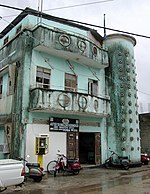List of heads of government of Zanzibar
Appearance
(Redirected from Prime Minister of Zanzibar)
| Chief Minister of Zanzibar | |
|---|---|
 | |
| Appointer | Sultan of Zanzibar (1961–1964) President of Zanzibar (1964–2010) |
| Formation | 5 June 1961 |
| First holder | Muhammad Shamte Hamadi |
| Final holder | Shamsi Vuai Nahodha |
| Abolished | 9 November 2010 |
 |
|---|
|
|
This is a list of the heads of government of Zanzibar, an semi-autonomous region of Tanzania. The office of Chief Minister (later changed to Prime Minister) was established in 1961 and abolished in 2010, having been previously abolished between 1964 and 1983.
List of officeholders
[edit]- Political parties
Afro-Shirazi Party (ASP)
Chama Cha Mapinduzi (CCM)
- Other factions
- Status
Denotes acting chief minister
Chief ministers of the Sultanate of Zanzibar
[edit]| No. | Portrait | Name (Birth–Death) |
Term of office | Political party | Sultan(s) | ||
|---|---|---|---|---|---|---|---|
| Took office | Left office | Time in office | |||||
| – | 
|
Geoffrey Charles Lawrence (1915–1994) |
23 February 1961 | 5 June 1961 | 102 days | Independent | Abdullah |
| 1 | 
|
Muhammad Shamte Hamadi (1907–aft. 1964) |
5 June 1961 | 24 June 1963 | 2 years, 19 days | Coalition (ZPPP + ZNP) | |
Prime minister of the Sultanate of Zanzibar
[edit]| No. | Portrait | Name (Birth–Death) |
Term of office | Political party | Sultan(s) | ||
|---|---|---|---|---|---|---|---|
| Took office | Left office | Time in office | |||||
| 1 | 
|
Muhammad Shamte Hamadi (1907–aft. 1964) |
24 June 1963 | 12 January 1964 (deposed.) |
202 days | Coalition (ZPPP + ZNP) |
Abdullah Jamshid |
Prime minister of the People's Republic of Zanzibar
[edit]| No. | Portrait | Name (Birth–Death) |
Term of office | Political party | President(s) | ||
|---|---|---|---|---|---|---|---|
| Took office | Left office | Time in office | |||||
| 1 | 
|
Abdullah Kassim Hanga (1932–1969) |
12 January 1964 | 27 April 1964 | 106 days | ASP | A. Karume |
Chief ministers of the Revolutionary Government of Zanzibar
[edit]| No. | Portrait | Name (Birth–Death) |
Term of office | Political party | President(s) | |||
|---|---|---|---|---|---|---|---|---|
| Took office | Left office | Time in office | ||||||
| Post abolished (27 April 1964 – 21 February 1983) | ||||||||
| 1 | 
|
Ramadani Baki (born 1943) |
21 February 1983 | 6 February 1984 | 350 days | CCM | Jumbe Mwinyi | |
| 2 | 
|
Seif Sharif Hamad (1943–2021) |
6 February 1984 | 22 January 1988 | 4 years, 16 days | CCM | Mwinyi Wakil | |
| 3 | 
|
Omar Ali Juma (1941–2001) |
25 January 1988 | 1 November 1995 | 7 years, 280 days | CCM | Wakil Amour | |
| 4 | 
|
Mohamed Gharib Bilal (born 1945) |
1 November 1995 | 15 November 2000 | 5 years, 14 days | CCM | Amour A. A. Karume | |
| 5 | 
|
Shamsi Vuai Nahodha (born 1962) |
15 November 2000 | 9 November 2010 | 9 years, 359 days | CCM | Karume Shein | |
| Post abolished (9 November 2010 – present) | ||||||||
Timeline
[edit]
See also
[edit]
- Politics of Tanzania
- List of governors of Tanganyika
- President of Tanzania
- Vice-President of Tanzania
- Prime Minister of Tanzania
- List of sultans of Zanzibar
- President of Zanzibar
- Vice President of Zanzibar
